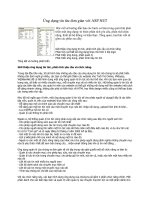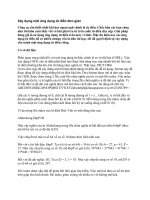Vẽ chân dung khuôn mặt đơn giản
Bạn đang xem bản rút gọn của tài liệu. Xem và tải ngay bản đầy đủ của tài liệu tại đây (365.52 KB, 9 trang )
How To Draw Faces
You Can Believe!
So you think learning how to draw faces is difficult?
Wrong!
All faces are made up of simple shapes like anything
else. Have a look at the article on using just five basic
shapes to draw anything by clicking here.
In the basic steps that follow, you'll be able to draw
believable faces from any angle or position, in no time
at all.
When learning how to draw faces, you'll find that you
can get the face to 'look right' from the start if you're
aware of some standard measurements that apply to
most people's faces.
Once you realise this and practice using them, your sketches of faces will improve no end.
Indeed, this is a vital first step if you want to
move onto doing portraits.
Remember, practice is everything when
learning how to draw faces. Copy examples
from photos, newspapers and magazines or
of course, you can use the examples in this
tutorial.
Get as wide a range of sketches as you can of
men, women, young adults, the elderly,
children, racial and ethnic backgrounds and
so on.
Draw faces from as many different angles and lighting conditions as possible. It's surprising
how the same face can look quite different in contrasting lighting conditions.
However, one step at a time. Let's get used to drawing a 'general' face that has all the relevant
bits in the right place!
Oh yes. And one other point.
The 'standard measurements' I've just mentioned are only a guideline, not an absolutely rigid
formula that must be adhered to. So use them as a valuable tool. Don't become a slave to
them!
How to Draw Faces - Stage 1
All we start with is a basic oval in Sketch A. Draw this in lightly and don't worry if it's not
perfectly symmetrical.
Few people have a head shape or features that
are identical on both sides of their face.
And here's the first standard measurement I'll call these SM from now on to save space.
The centre of the eyes are placed halfway
down the oval - not about a third of the way
as you may think. Also, the ears are attached
to the head on line with the eyes.
The bottom half of the oval can now be split in two again to fix the position of the tip of the
nose. The remaining space below this is also divided in two and the imaginary line here
positions the mouth.
Even though Sketch B shows this with the eyes & ears, nose and mouth only very simply
defined, you can see how everything 'looks right' already
How to Draw Faces - Stage 2
Now another couple of SM's to help you. In Sketch C, the distance between the centre of
the eyes and the tip of the nose invariably works out an equal-sided (equilateral) triangle.
In fact many portrait artists start with this triangle to position the eyes and nose on the canvas
or paper before even constructing the head shape. Now look closely at the dotted lines that
drop down from the centre of the eyes. Notice that they meet the outer edges of the mouth.
How to Draw Faces - Stage 3
Moving onto the side view of the face, you can see that in Sketch D the oval shape is still
there, except that it has been tilted slightly to the right, with one side, (the jaw area) being
slightly flattened.
In Sketch E another SM comes into play. People's ears tend to be further back on their head
than may at first appear.
So the distance from the outer edge of eye to the back of the ear is usually the same as the
distance from the eye to the chin.
How to Draw Faces - Stage 4
Right, you now have the basic shape of your face from both the front and side views. Now
comes my favorite bit when we make the head three-dimensional. Let's go back to the basic
oval for a minute (Sketch F).
The dotted lines are still there but the big
difference is that they have been slightly rounded.
Compare this to Sketch A to see what I mean. See
what happens in Sketch F?
Even though there are no features on the face, the
dotted lines on a curve give the clear impression of
a rounded solid object. In this case, it's a head, but
it could be a ball, an egg, a cushion or whatever.
Now add some basic features following the curved dotted lines as in Sketch G and
suddenly, with no effort, you have a 3D head. It's that easy!
Again, compare Sketch G to Sketch B. Remember, the features must follow the curved lines
to achieve this effect.
How to Draw Faces - Stage 5
Now that we know how to draw faces that are three-dimensional, it's only a small step to
learning how to move the position of the head, both from side to side and looking at it from
above and below as well.
In Sketch H I've made the dotted lines curve
quite sharply upwards to the right of the head,
whilst the dotted line for the centre line of the
head is almost at the left hand edge.
Now as soon as I put the basic features along
these lines, they are automatically positioned
with the face looking downwards and to the left.
In Sketch I, I've done the opposite with the
dotted lines so the face is now looking upwards
to the right.
The only extra mark I've added is a hint of the chin. The best way to really get to grips with
this is to put your curved dotted lines in all sorts of positions on the head without at first
trying to fix a facial position.
Then add the features and see which way your face is looking. You'll soon get the hang of
where the curves should go for any angle at which you want your face to be set.
How to Draw Faces - Stage 6
Having achieved a 3D effect we now know how to draw faces with the head at the correct
angle. Now it's time to add some shadows and highlights to create the essential character of
the face.
If we go to the front-on face position as in Sketch J, you can see where
some simple shadows have been created by 'hatching'. In this case, I've
assumed the light is coming from the right, so most of the shadows are
on the left side of the face.
Although all the shadows are important, I want you to note three areas in particular that do
more than anything to suggest to the viewer that features are protruding from or set into the
face.
Firstly, the shadows immediately above both eyes - even the right eye which is getting some
direct light - tells us that the eyes are recessed into the eye sockets.
Second, look how the shape of the nose and the impression that it comes forward from the
face, is defined by no more than the shadow on the left hand side and the flattened 'V'
representing the nostrils, with a little more shadow underneath.
Thirdly, Note that the bottom lip is not always drawn in full. It often looks better if its
presence is suggested by a little shadow underneath. This shadow then immediately fades
away and the highlight below it tells us that this is the front of the chin protruding slightly.
How to Draw Faces - Stage 7
Adding hair styles is very straightforward. You can be as creative as you like here, both for
men and women. The examples in Sketch K give you some ideas.
How to Draw Faces - Stage 8
Finally, we bring the whole tutorial together to produce two 3D faces, complete with hair,
shadows and highlights.
Let's start with the two photos of the faces we'll be using. The view of the woman is from
below and to the left whilst that of the man is above from the left.
You can see from the photos how the guidelines I've super-imposed confirm what I've said
about things like the eyes being half-way down the head and the tip of the nose being halfway
between the eyes and the chin, etc.
From there, I've used the principles outlined earlier to create these two sketches. Although I
think they're a reasonable likeness, they're only really a couple of practice sketches, designed
to prove the theories I've mentioned actually work.
Notice also how I've added shading to bring out the shapes of different parts of the face. The
shadows under the nose, chin, around the eyes and the bottom lip are particularly important in
creating the bone structure of the subject.
At the early stages of learning how to draw faces, don't beat yourself over the head if the
exact likeness doesn't happen the first few times.
It does take practice until bringing all these ideas together starts to become automatic. A bit
like learning to drive a car or a honing a golf swing.
Remember, a few quick sketches, each produced in a few minutes, will bring on your skills
very quickly.
You don't need to set a whole evening to one side. In fact, sketching faces like this is not
much more than creative doodling. However, it's an excellent means of developing your style
and drawing confidence in small, bite-sized chunks of time.
If you've ever been stuck in a boring meeting (in my case, hundreds of them in my previous
life) then the agenda papers and minutes are ideal to practice on!
With a bit of effort, you can easily produce these faces (hopefully even better!) in not much
more time than it takes you to read this article. So go on - have a go and surprise yourself!
Click here to return from this how to draw faces page
to the main learn to draw section
About Bob
Read a bit more about Bob Davies, the creator and presenter of How to Draw
and Paint and why he believes... Keep going...
What Visitors Say
Genuine, Unsolicited Support
Happened to find your friendly manner of presentation. That is a gift Bob. Through that gift,
you can't help but touch people. Stay well.
Ron S.
Hi Robert, just want to say thank you so much for your lessons, so much information and
learning in them, and the videos are wonderful. Love your art and the art displayed on the
links. Once again thanks, you have no idea of the enjoyment they bring.
Judy L.
Read more or leave your own...
About bob | Search Website | Your Privacy | Contact Us
Copyright (c) how-draw-and-paint.com All rights reserved.
A subsidiary of PaintBox Art Media Ltd. Company No: 6410698
Hesketh Mount | 92-96 Lord Street | Southport | Merseyside | PR8 1JR | England









